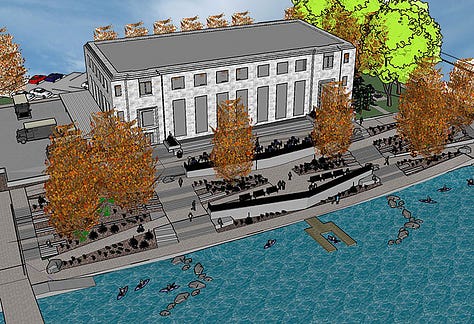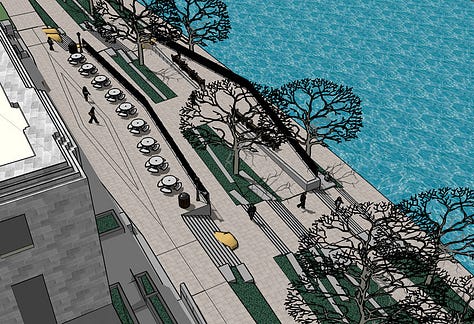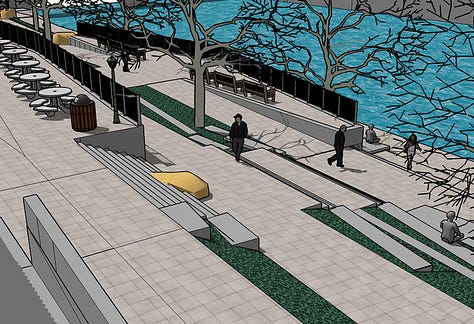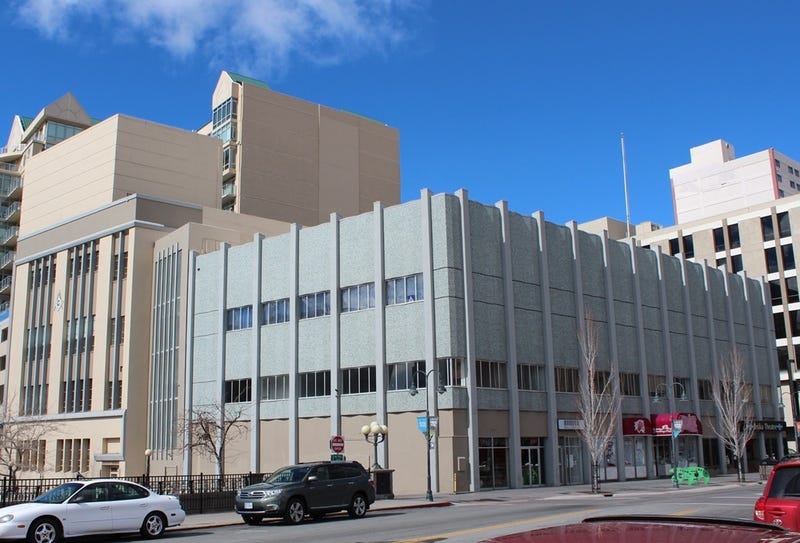In terms of sheer beauty and mass appeal, downtown Reno has no asset more valuable than the Truckee River. After all, rivers are givers of life—not just literally, but in their endless power to mesmerize and delight, the ideal backdrop for conversation or contemplation, buoyant conveyers of everything from ducks to kayakers.
Any town with a river running through it recognizes its potential to revitalize not just our collective spirits but the surrounding urban fabric. Historically, Reno didn’t crowd its river with commercial development like many others because the water wasn’t navigable; it couldn’t transport goods and passengers. Instead, residents valued the Truckee for its role in irrigation, sustenance, and recreation. While businesses clustered around the railroad and U.S. 40 (Fourth Street), several blocks to the north, the historic riverfront remained the domain of comfortable homes, churches, libraries, post offices, and schools.
These days most of us recognize the incredible value of the Riverwalk District to both civic revitalization and tourism. We’ve noted the success of the outside seating at Campo, Smee’s, and the Ole Bridge Pub on the ground floor of the Palladio, the expansive deck at the Renaissance Hotel, or the outside patio of the Wild River Grille. When all that seating is packed, sometimes with live music playing, there is a palpable energy in the air and a sense that the river is the place to be. That vitality is a function of proximity, the cumulative effect of thriving riverfront destinations within view and earshot of each other.
It’s surprising, then, that recent discussions about riverfront development have focused on quieter sites upstream, like the future Kimpton Hotel and whatever Artown might do with the Lear Theater. What seems to have gotten lost in the hubbub is attention to the unmet potential of some of the most critical sites along the river, the spaces surrounding the Virginia and Sierra Street bridges, at the heart of it all. If we like what’s happening at Campo or the Wild River Grille, we need to build on the vitality they have generated by filling in the gaps around them to create a continuous, thriving district.
Some of these sites currently have features many of us like, but it’s time to take a step back, consider the big picture, and contemplate what more these spaces can do for the city and its people. Contentment with the status quo can prevent us from making these spaces everything they can be—and what our city leaders decided long ago that they should be. So consider this my call to restart these conversations and get revitalization of the riverfront back on track.
10 N. Virginia Street (City Plaza)

This first site is a sensitive one, I know—not just because the Mapes Hotel, beloved to so many, was imploded by the City of Reno with perhaps a little too much enthusiasm, but because what took its place was not what we were promised. Today the City Plaza is best known as a large open space for periodic gatherings, marches, and speeches, the home of two large-scale sculptures, and a whole lotta concrete.
It’s no slam on the sculptures or the gatherings to say that this space can be doing a lot more for us. That was always the intent, after all. It’s important to remember that the Mapes wasn’t imploded in 2000 because it was deemed impossible to renovate. It was razed because City leaders grew impatient with waiting for a viable restoration plan for what they considered “blight” and thought that a cleared riverfront lot would be an easier sell to a developer who might build something new and exciting there, something that would completely transform the area.
That didn’t happen. So City leaders decided to house the seasonal ice rink there, integrating that function into a year-round city plaza. An international design competition launched in 2003, drawing entries from the likes of landscape architect Peter Walker, who went on to design the 9/11 memorial at the World Trade Center. The City selected local firm SVWB, whose design featured a circular ice rink with a permanent canopy, amphitheater seating, and a mixed-use building on the Center Street side, potentially housing skate rentals, a café, and/or a restaurant cantilevered over the river.
The recession killed most of that plan (no canopy, no building), and logistical problems tanked the seasonal ice rink. The sculptures eventually installed on the concrete might make nice backdrops for speeches and photo ops, and even land in a magazine feature every once in a while, but the vast majority of the time, the plaza sits largely vacant, a vast, dull space, lacking even comfortable places to sit.
When we objectively evaluate what a site’s potential uses could and should be, we have to ask ourselves two important questions:
Can the site’s current functions take place just as effectively somewhere else?
What purpose can this site serve that ONLY it can serve?
The answer to me is clear: this space deserves a do-over. We already can (and do) place large-scale sculptures close by, in Bicentennial Park and along West 4th Street. We can gather for public events just as easily in nearby Wingfield Park (which actually has a stage and amplification system) or the ReTRAC East Plaza, both sites that have already been designated as permanent open space. Without the need for an ice rink, this site can house a range of things—think a multi-story building with offices and apartments, ground-level eateries, landscaped shade trees and seating areas. Or something smaller scale but bursting with trees, flowers, water features, and seating. The sky’s the limit, so let’s think big and figure out how to infuse this pivotal space with the constant hubbub of activity that the “city’s front porch” deserves.
16 S. Sierra Street (The Eddy)

What do I have against The Eddy? Absolutely nothing. I think The Eddy is great. It just shouldn’t be a permanent fixture in its current location. Its operators stated as much during the approval process back in 2016, when they signed a five-year lease and expressed their openness to operating in other spaces down the road. By my reckoning that puts their renewal date up about now, so this is the perfect time to pivot, and take steps toward transforming this key site into a higher-density use with year-round appeal.
Again, something higher density was the original plan, pre-recession. Longtime residents will recall that this lot once housed the 1950 addition to the Riverside Hotel-Casino. The casino closed in 1987, and with the revitalization of the original 1927 hotel into the Riverside Artist Lofts in 2000, the mid-century addition was demolished.
The Reno Redevelopment Agency then owned the vacant lot. And in 2003-2004, the plan was to facilitate construction of a multi-story structure that would capitalize on the adjacent Riverwalk and complement without competing with the historic Riverside. I served on the City’s Historical Resources Commission at the time, and we reviewed several proposals include the one pictured above. At the City’s direction, any proposal had to step back from the historic building next door, but could rise higher on the rear and Sierra Street sides. The proposals included parking for residents and ground-level, river-facing amenities.
Then the recession hit. The mixed-use Palladio, across the river at 50 N. Sierra Street, was constructed, but plans for this site fell apart. And in 2007, as I just found out, the lot was conveyed to a company called Freight House District LLC in a land exchange related to the construction of the ballpark (now Greater Nevada Field). The Eddy folks came by in 2016 and proposed their seasonal outdoor attraction, which required special permission since the parcel was zoned for much higher density, and here we are.
It’s no slam against The Eddy to say that this site needs to be doing more for the city than it’s doing now. If the property’s owners can’t or won’t build a higher-density mixed use building with year-round appeal, they need to sell it to someone who will. And who knows, maybe The Eddy can move across the river to City Plaza until a permanent plan for that site can be developed.
40 W. First Street (The Masonic Building)
I want to be very clear in affirming that the Masonic Building is a perfectly fine building with wonderful tenants. It is a fixture in the city center, and rightly so. But structurally and functionally, the building simply does not take advantage of its prime riverfront location. The 1906 Masonic Temple built on this site burned in 1965 and was razed and replaced. The second section was constructed in the 1950s, with both portions facing away from the river, like many of the original buildings on the north bank. Today, most of the south façade is a long blank wall that does nothing to generate pedestrian-level interest or activity.
Facing Virginia Street, Bruka Theatre and the wedding chapel are fantastic for the district, but I can’t help but wonder what more might be done with the building—perhaps a structural revamp with large glass windows facing the Truckee? Or maybe a new structure altogether, completely re-envisioned, even taller? I’m not sure what the Reno Masonic Temple Association has in mind for the long-term, but the topic seems worthy of exploration.
50 S. Virginia Street (The Historic Downtown Post Office)

The 1934 Downtown Post Office building was beautifully restored and repurposed after the decommission of the post office in 2012. If you’ve been inside, you know that it has one of the most spectacular interiors in the city. Unfortunately, the pandemic hit just as things were starting to pick up for West Elm and all the independent shops and services in The Basement, which hopefully will bounce back as the world reopens for business. The top two floors house offices of various sizes.
The problem in terms of activating the riverfront is what lies between the beautiful building and the river: a parking lot. Although originally landscaped with a grassy lawn and trees, it’s been a parking lot for a very long time. However, redevelopment proposals dating back to the 1960s have envisioned something much different there, like a plaza with landscaping, planters, and benches. What a great addition to the riverfront that would be.



It might be a hard sell to ask the property’s owner to give up its private parking, but with so much available parking nearby, including multi-level garages just across the river (and its own loading dock for anyone needing to pick up a sizeable purchase), I can’t help but wonder if some kind of accommodation could be made. Outdoor seating could be an incredible boost to the building’s tenants, providing space for customers to eat and drink what they’ve purchased inside and encouraging them to linger longer on site.
So that’s my pitch! Who else is ready for the conversation?
February 24th Reno City Council Meeting
Tomorrow’s Reno City Council meeting will include two presentations of particular interest:
D.2: A report on the status of the replacement of the Arlington Avenue Bridges from RTC Washoe.
D. 4: A report on the new East 4th Street public art piece to be installed at the Wells Avenue overpass.
You can view the entire meeting agenda and accompanying materials here.
BRIEF TIP: Follow Downtown Makeover
As construction continues to progress throughout Reno, Mike Van Houten keeps track of what’s going on (and up) on his fantastic site Downtown Makeover, also posting on Facebook, Twitter, and Instagram. In addition, the website features descriptions of existing residential developments, districts, and attractions. It’s a must-read.
As always, you can view my previous e-newsletters, with more context, analysis, and tips, on my Substack site, https://thebarberbrief.substack.com/. Have a great week!






Alicia, you are right on. We are blessed with on of the most beautiful rivers in the country. Our town can be so much more. The bones are here but if we keep tearing them down without vision we are lost. This dialogue needs to continue.
Thank you for this perspective, Alicia. The first time I ever set foot in Reno (2012) I thought, WOW this river front is SO under-utilized for how beautiful the setting is, complete with mountain views in the distance. Perhaps the city should trade the City Plaza for the site next to the Hub ;-) This is the place where something of scale should be built.